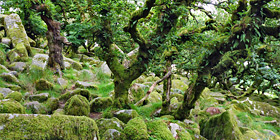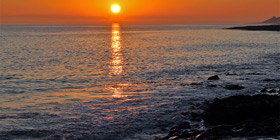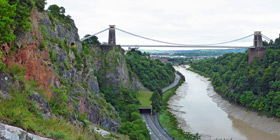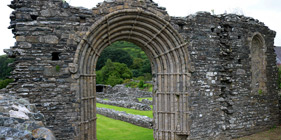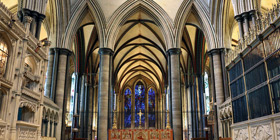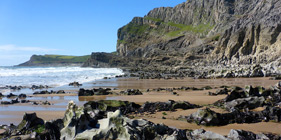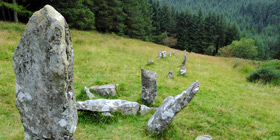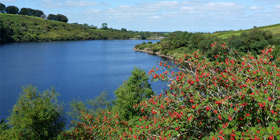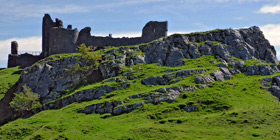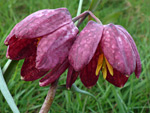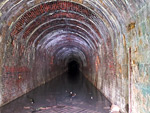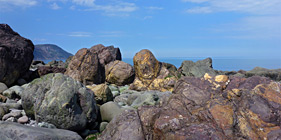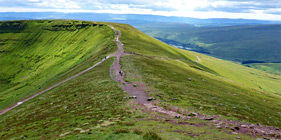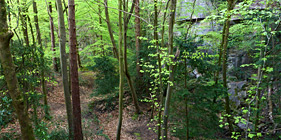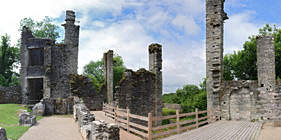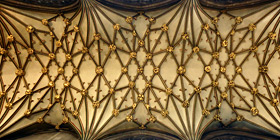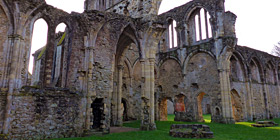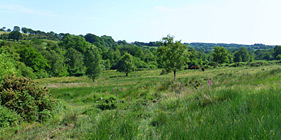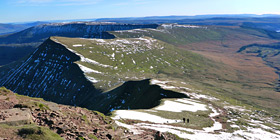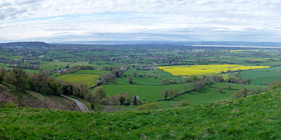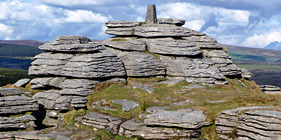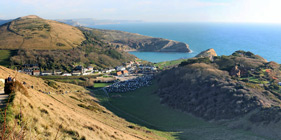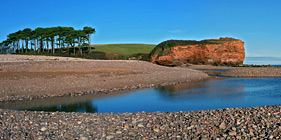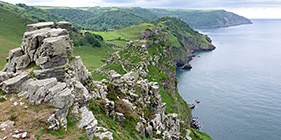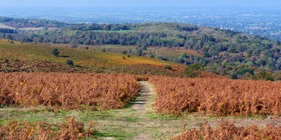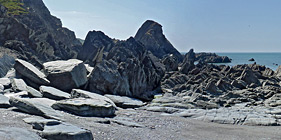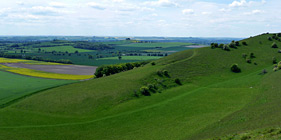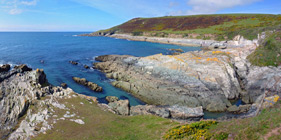Photogenic places in southwest UK, in England and Wales, generally within 80 miles of Bristol; landscapes and historic sites, scenery and heritage, including coastlines, mountains, wildflowers and nature reserves, castles, cathedrals and ruined abbeys
What's New?
December 1st
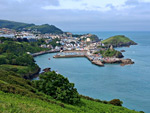
Lee Bay to Combe Martin,
Devon

Lee Bay to Combe Martin,
Devon
November 10th
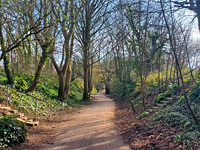
Strawberry Line,
Somserset

Strawberry Line,
Somserset
August 19th
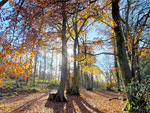
Westridge Wood, Gloucestershire

Westridge Wood, Gloucestershire
Future articles include: Edge Common, Nant Cwm-du, New Forest, Pembrokeshire, Snowdonia, Watlington Hill
Locations
Beaches and cliffs along the coasts of Devon, Dorset and Somerset in England, and Bridgend, Swansea and Vale of Glamorgan in Wales. Explorable from above via the coast path, or below by walking directly along the shoreline |
The Brecon Beacons are the only true mountains in southwest UK but there are other scenic, high elevation regions including the moorland of Exmoor and Dartmoor, and the hills of the Malverns, Quantocks, and Mendips |
Nature reserves may contain meadows, ancient woodland, heath, gorges, hills, lakes, wetlands, coastal bluffs, abandoned railway lines and old quarries, and many are of interest because of the natural landscapes in addition to the plants and wildlife |
Medieval castles and fortified mansions, most in various stages of ruin, though a few are still intact and partly furnished. They range in location from city centres to remote countryside |
Cathedrals of the southwest, and a selection of some of the largest and most historic parish churches, together amongst the best preserved buildings from the early medieval period |
Religious ruins, mostly of ancient Catholic monasteries that were closed during the Reformation, many still displaying spectacular architecture, in atmospheric settings |
Counties
England
Berkshire | |
| Donnington Castle is a ruined, 13th century fortified manor house; landscapes in the county include Bucklebury Common, Inkpen Common and Snelsmore Common | |
Bristol | |
| Avon Gorge is a spectacular limestone gorge along the River Avon, while Bristol Cathedral and St Mary Redcliffe are the two oldest and most famous religious buildings | |
Buckinghamshire | |
| Homefield Wood is a nature reserve conganing a number of rare plant species | |
Devon | |
| Devon has much spectacular coastline, including Axmouth to Lyme Regis, Beer Head, Glenthorne Beach to Foreland Point, Sidmouth to Ladram Bay and Valley of Rocks to Woody Bay, together with a fine selection of castles, such as Berry Pomeroy, Dartmouth, Okehampton and Totnes. Two other highlights are Exeter Cathedral and Lydford Gorge | |
Dorset | |
| Durdle Door and Lulworth Cove and Lyme Regis to Seatown are two especially famous sections of the Dorset coastline, while the county contains over a dozen ancient castles, including Christchurch, Corfe, Portland, Sandsfoot and Sherborne. Shaftesbury Abbey is perhaps the finest medieval church | |
Gloucestershire | |
| Ancient buildings in Gloucestershire include Berkeley Castle, Gloucester Cathedral, Tewkesbury Abbey and Hailes Abbey, this latter a very photogenic ruin. The county is home to an especially large and varied collection of nature reserves, the best being Crickley Hill, Daneway Banks, Lancaut, Lower Woods, Sapperton Valley and Swift's Hill, and also Westonbirt Arboretum | |
Hampshire | |
| Four highlights of Hampshire's ancient architecture are Netley Abbey, Portchester Castle, the Roman settlement of Silchester, and Winchester Cathedral. Notable landscapes include Ashford Hangers and Pamber Forest | |
Herefordshire | |
| Goodrich, Kilpeck, Longtown and Wigmore are the best ruined castles in Herefordshire, while medieval churches of note include Dore Abbey, Hereford Cathedral and Madley | |
Oxfordshire | |
| Oxfordshire contains a selection of ancient ruins such as Minster Lovell Hall and Wallingford Castle. Landscapes include chalk streams and the hills of the Chilterns, such places as Aston Rowant, Hartslock and Letcombe Valley | |
Somerset | |
| Brean Down, Lilstock to St Audrie's Bay, Minehead to Hurlstone Point, Porlock Weir to Glenthorne Beach and Sand Point are amongst the most scenic sections of the Somerset coast, while other landscapes, some protected as nature reserves, include Black Down and Burrington Combe, Crook Peak, Leigh Woods and Walton Common. The most impressive religious buildings are Bath Abbey, Glastonbury Abbey and Wells Cathedral | |
Surrey | |
| Surrey contains many areas of heath and open land, including Puttenham Common, Chobham Common and Bagshot Heath | |
Wiltshire | |
| The varied attractions of Wiltshire include churches (Malmesbury Abbey and Salisbury Cathedral), prehistoric sites (Avebury and Stonehenge), castles (Ludgershall, Old Sarum and Old Wardour) and nature reserves, such as Coombe Bissett Down, Dunscombe Bottom and Lower Moor Farm | |
Worcestershire | |
| The Malvern Hills are the most impressive landscape feature in Worcestershire. Historic churches include Great Malvern Priory, Little Malvern Priory, Pershore Abbey and Worcester Cathedral | |
Wales
Blaenau Gwent | |
| Silent Valley Nature Reserve, a wooded valley near Ebbw Vale | |
Bridgend | |
| Bridgend is a small county, with two excellent coastal nature reserves, Kenfig and Merthyr Mawr, plus a few castles including Candleston, Coity and Newcastle | |
Caerphilly | |
| Caerphilly Castle, an extensive 13th century fortification surrounded by moats and lakes | |
Cardiff | |
| Coed-y-Bedw, atmospheric woodland crossed by several streams | |
Carmarthenshire | |
| Ancient sites in Carmarthenshire include Talley Abbey, and the castles of Carreg Cennen, Dinefwr and Dryslwyn | |
Ceredigion | |
| Strata Florida Abbey is a beautiful ancient ruin; landscapes include Cors Caron and the Teifi Pools | |
Merthyr Tydfil | |
| Three attractions of Merthyr Tydfil are Morlais Castle, a 13th century ruin on an exposed limestone hill, the deep, wooded valley of the Taf Fechan River, and the limestone uplands of Darren Fawr Nature Reserve | |
Monmouthshire | |
| There are nine medieval castles in Monmouthshire, the best being Caldicot, Chepstow, Grosmont, Raglan and White. Llanthony Priory and Tintern Abbey are two spectactular monastic ruins. There are also many nature reserves, such as Prisk Wood, hidden valleys like Clydach Gorge, and outlying hills of the Brecon Beacons, such as Skirrid Fawr | |
Neath Port Talbot | |
| The three main historic sites in Neath Port Talbot are the partial ruins of Margam Abbey and Neath Castle, and the more extensive remains of Neath Abbey | |
Newport | |
| Caerleon has extensive remains of a first century Roman settlement. Great Traston Meadows Nature Reserve comprises marshy grassland on the Gwent Levels | |
Powys | |
| The many castles of Powys incude Bronllys, Dinas, Crickhowell, Dolforwyn, Hay, Montgomery and Tretower, but the county is most famous for its landscapes, including most of Brecon Beacons National Park; such locations as Black Mountain Fans, Caerfanell Valley, Fan Fawr, Henrhyd Falls, Llangattock Escarpment, Pen y Fan, Table Mountain, Waun Fach and Waterfall Country | |
Rhondda Cynon Taf | |
| Llantrisant Castle is a minor, overgrown ruin, while Afon Hepste and Sychryd Gorge are narrow valleys with waterfalls | |
Swansea | |
| The Gower Peninsula forms most of the county of Swansea, famous for castles (Loughor, Oxwich, Oystermouth, Pennard, Penrice, Swansea and Weobley), and of course the coastline, some of the best locations being Caswell Bay, Port Eynon, Three Cliffs Bay, Whiteford and Worm's Head | |
Torfaen | |
| Henllys Bog Nature Reserve is a small, remote site containing several rare plant species | |
Vale of Glamorgan | |
| The Glamorgan coastline is lined by beaches and spectacular, eroded cliffs, such as Aberthaw to Stout Bay, Dunraven Bay, Nash Point to Stout Bay, Ogmore-by-Sea and Sully Island to Lavernock Point. Historic sites include Ewenny Priory and the castles of Barry, East Orchard, Ogmore Castle, Old Beaupre, Penmark and St Quintin's | |
National Parks and Areas of Outstanding Natural Beauty
Descriptions and photographs of some of the many flowering plants of southwest England and Wales
County Location Map
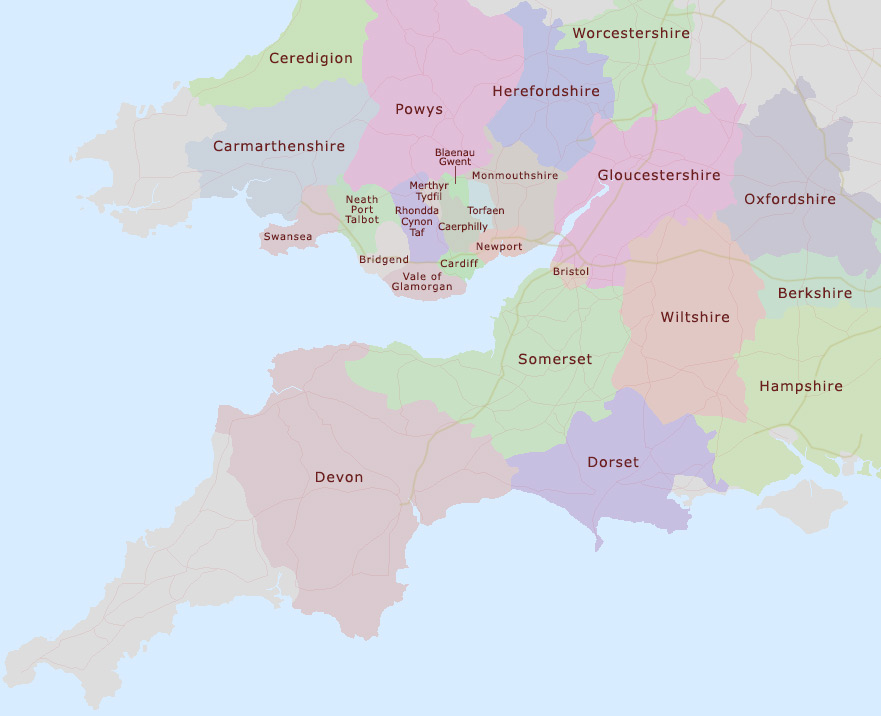

Featured landscapes are places which are scenic, undeveloped, and sometimes wild and remote, and so are somewhat uncommon in the south of the UK; the most extensive region is Brecon Beacons National Park in Wales, while second is Exmoor National Park in Devon and Somerset. Apart from these places, and some smaller ranges of hills, the other main type of unspoilt and sometimes difficult-to-reach landscape is the coast, especially the beaches at the foot of lengthy, cliff-bound sections; there are many beautiful stretches of shoreline, not often explored, in south Wales, in Devon and Somerset, and in counties to the south.
Featured historic sites are mostly those which are both old - medieval or earlier - and substantial; usually but not necessarily a ruin. Castles and abbeys are the most photogenic of such locations, while other places include Roman and Neolithic relics, and also cathedrals, which combine spectacular architecture with varied history.
Ratings are a guide to how good a photographic subject the locations are, also taking into account the prettiness of the surroundings, the historical importance (where relevant), and the general enjoyment when visiting.
